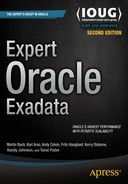Contents
Alternative Views of What Exadata Is
Exadata Storage Expansion Rack X5-2
![]() Chapter 2: Offloading / Smart Scan
Chapter 2: Offloading / Smart Scan
How to Verify That Smart Scan Is Happening
Session Performance Statistics
![]() Chapter 3: Hybrid Columnar Compression
Chapter 3: Hybrid Columnar Compression
Disassembling the Oracle Block
What Happens When You Create a HCC Compressed Table?
Moving Data to a Non-Exadata Platform
Disabling Serial Direct Path Reads
Special Optimization for Nulls
Physical Distribution of Values
Incompatible Coding Techniques
![]() Chapter 5: Exadata Smart Flash Cache
Chapter 5: Exadata Smart Flash Cache
Flash Memory in Exadata X4-2 Storage Servers
Flash Memory in Exadata X5-2 Storage Servers
Mixed Workload and OLTP Optimizations
Using Flash Memory for Database Logging
Using Flash Memory to Accelerate Writes
Miscellaneous Other WBFC-related Optimizations
Enabling the Write-back Flash Cache
![]() Chapter 6: Exadata Parallel Operations
Chapter 6: Exadata Parallel Operations
Parallelization at the Storage Tier
Parallel Statement Queueing Wrap-Up
Troubleshooting Parallel Execution
![]() Chapter 7: Resource Management
Chapter 7: Resource Management
Types of Database Consolidation
Instance Caging Usage and Results
Instance Caging and Multitenancy
Binding Instances to Specific CPUs Using Cgroups
Installation and Configuration of Cgroups
Creating a (Pluggable) Database Resource Plan
Using the Scheduler to Change the Resource Plan
The Wait Event: resmgr: cpu quantum
Consumer Group Mappings Using ORACLE_FUNCTION
Monitoring the Resource Manager
Configuring Interdatabase IORM
I/O Resource Manager and Pluggable Databases
Resource Management Directives Matrix
![]() Chapter 8: Configuring Exadata
Chapter 8: Configuring Exadata
About the Configuration Process
Step 1: Gathering Installation Requirements
Step 2: Run Oracle Exadata Deployment Assistant
Step 3: Create Network VLANs and DNS Entries for Hostnames
Step 4: Run CheckIP to Verify Network Readiness
Step 5: Run Cables and Power to Exadata Racks
Step 6: Perform Hardware Installation
Step 7: Stage OneCommand Files and Oracle Software
Step 8: Configure the Operating System
Upgrading the Existing Cluster
Backing Up the Database Servers
Exadata Optimizations for RMAN
![]() Chapter 10: Exadata Wait Events
Chapter 10: Exadata Wait Events
Plan Steps That Trigger Events
Exadata Wait Events in the User I/O Class
cell single block physical read
cell list of blocks physical read
Minor Events in the User/IO Class
Exadata Wait Events in the System I/O Class
cell smart restore from backup
Exadata Wait Events in the Other and Idle Classes
Enq: KO—fast object checkpoint
![]() Chapter 11: Exadata Performance Metrics
Chapter 11: Exadata Performance Metrics
Measuring Exadata’s Performance Metrics
Revisiting the Prerequisites for Exadata Smart Scans
Exadata Smart Scan Performance
Understanding Exadata Smart Scan Metrics and Performance Counters
Exadata Dynamic Performance Counters
When and How to Use Performance Counters
The Meaning and Explanation of Exadata Performance Counters
Performance Counter Reference for a Selected Subset
Understanding SQL Statement Performance
Querying cellsrv Internal Processing Statistics
![]() Chapter 12: Monitoring Exadata Performance
Chapter 12: Monitoring Exadata Performance
Monitoring SQL Statement Response Time
Monitoring SQL Statements with Real-Time SQL Monitoring Reports
Monitoring SQL Statements Using V$SQL and V$SQLSTATS
Monitoring the Storage Cell Layer
Accessing Cell Metrics in the Cell Layer Using CellCLI
Accessing Cell Metrics Using the Enterprise Manager Exadata Storage Server Plug-In
Monitoring Exadata Storage Cell OS-Level Metrics
![]() Chapter 13: Migrating to Exadata
Chapter 13: Migrating to Exadata
Copying Data over a Database Link
Cross-Platform TTS with Incremental Backups
Wrap Up Physical Migration Section
Creating FlashDisk-Based Grid Disks
Configuring ASM-Scoped Security
Configuring Database-Scoped Security
![]() Chapter 15: Compute Node Layout
Chapter 15: Compute Node Layout
Quarterly Database Patch for Exadata
Applying a QDPE by Cloning Homes
Exadata Storage Server Patches
Applying an Exadata Storage Server Patch
Applying Patches to Standby Systems
![]() Chapter 17: Unlearning Some Things We Thought We Knew
Chapter 17: Unlearning Some Things We Thought We Knew
Exadata Smart Flash Cache (ESFC)
Write-Intensive OLTP Workloads
Things That Can Cripple Smart Scans
Sending Commands from the Operating System
Using cellcli XML Output in the Database
Configuring and Managing the Storage Cell
![]() Appendix B: Online Exadata Resources
Appendix B: Online Exadata Resources
